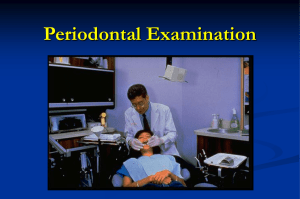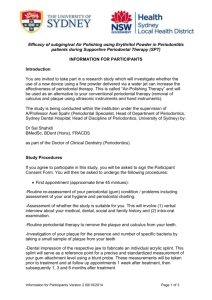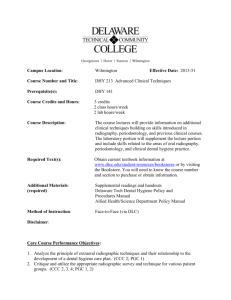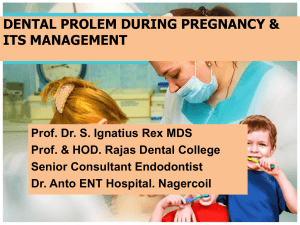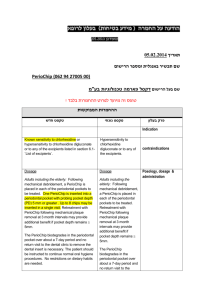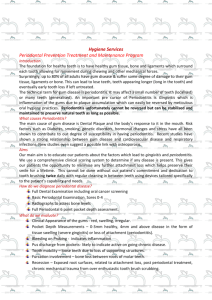View Syllabus - Walla Walla Community College
advertisement
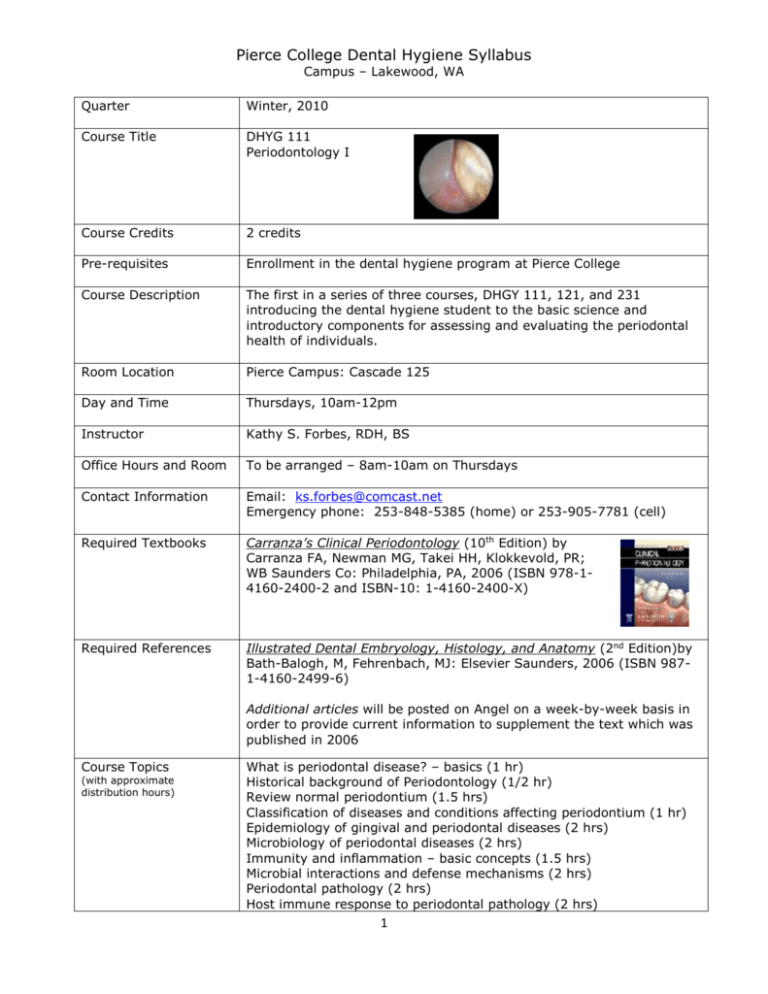
Pierce College Dental Hygiene Syllabus Campus – Lakewood, WA Quarter Winter, 2010 Course Title DHYG 111 Periodontology I Course Credits 2 credits Pre-requisites Enrollment in the dental hygiene program at Pierce College Course Description The first in a series of three courses, DHGY 111, 121, and 231 introducing the dental hygiene student to the basic science and introductory components for assessing and evaluating the periodontal health of individuals. Room Location Pierce Campus: Cascade 125 Day and Time Thursdays, 10am-12pm Instructor Kathy S. Forbes, RDH, BS Office Hours and Room To be arranged – 8am-10am on Thursdays Contact Information Email: ks.forbes@comcast.net Emergency phone: 253-848-5385 (home) or 253-905-7781 (cell) Required Textbooks Carranza’s Clinical Periodontology (10th Edition) by Carranza FA, Newman MG, Takei HH, Klokkevold, PR; WB Saunders Co: Philadelphia, PA, 2006 (ISBN 978-14160-2400-2 and ISBN-10: 1-4160-2400-X) Required References Illustrated Dental Embryology, Histology, and Anatomy (2nd Edition)by Bath-Balogh, M, Fehrenbach, MJ: Elsevier Saunders, 2006 (ISBN 9871-4160-2499-6) Additional articles will be posted on Angel on a week-by-week basis in order to provide current information to supplement the text which was published in 2006 Course Topics (with approximate distribution hours) What is periodontal disease? – basics (1 hr) Historical background of Periodontology (1/2 hr) Review normal periodontium (1.5 hrs) Classification of diseases and conditions affecting periodontium (1 hr) Epidemiology of gingival and periodontal diseases (2 hrs) Microbiology of periodontal diseases (2 hrs) Immunity and inflammation – basic concepts (1.5 hrs) Microbial interactions and defense mechanisms (2 hrs) Periodontal pathology (2 hrs) Host immune response to periodontal pathology (2 hrs) 1 Course Outcomes 1. Discuss the historical background of Periodontology from early civilizations until post World War II (A,T) 2. Identify, discuss and explain the function of the normal/healthy periodontal structures of the periodontium using correct terminology: marginal gingival; gingival sulcus; attached gingival; interdental gingival; alveolar gingival; mucogingival junction; gingival epithelium; gingival connective tissue; periodontal ligament (fibers, ground substance); cementum (types, permeability, cementoenamel junction, resorption, repair; alveolar process (socket wall, bone marrow, periosteum, endosteum, and etc. (A, T) (1.3,2.2,3.2,3.3,11.1) 3. Identify and explain the histological features and embryological development of the periodontal structures in health and in a diseased state. (A, T) (3.2,3.3) 4. Discuss and describe the effects of aging on the periodontium. (A, B, T, Z) 5. Describe, define and list the current American Academy of Periodontology (AAP) classifications of periodontal diseases and their epidemiology. Compare, contrast and differentiate from previous classifications. (A, D, T) (3.2,3.3) 6. Use and apply the AAP classifications to analyze and provide a dental hygiene diagnosis for case studies in class and eventually, for clinical patients. (A, B, T, Z) 7. Describe and discuss the inflammatory process and immune system. This includes identifying and describing the vascular response to injury, the chemical mediators in vascular response, the blood leukocytes and their respective roles or functions. (A, F, T) (3.2,3.3) 8. Identify the AAP classification for patients from written case descriptions which may include narratives, photos, x-rays, etc. (F, T) (3.1,3.2,8.3) Optional References Lexicomp ONLINE for Dentistryv2009 Periodontology for the Dental Hygienist (3rd Edition) by Perry, DA & Beemsterboer, PL; Saunders: Philadelphia, PA, 2007. (ISBN-13: 9781-4160-0175-1 and ISBN-10: 1-4160-0175-1) Manual of Clinical Periodontics by Serio FG & Hawley, CE; Lexi-Comp, Inc.: Hudson, OH, 2002. (ISBN 1-930598-82-3) Fundamentals of Periodontics (2nd Edition) by Wilson, TB & Kornman, KS; Quintessence Publishing: Chicago, 2003. (ISBN 0-86715-405-5) Method of Instruction Course instruction will utilize a variety of approaches: Lecture Classroom/group discussion Group assignments, projects and presentations Instructor observation Written examinations Student Conduct Policy Please refer directly to the Pierce College Student Code of Conduct and the Pierce College Dental Hygiene Program Student Handbook for the general guidelines of conduct within and related to this class. Professional behavior is expected. Please remember that you signed and agreed to all of the rules, policies, criteria, etc. set forth in the handbook. In addition, please review for the use of cell phones in the classroom and clinic. 2 Course Evaluation As with most courses within the Dental Hygiene Curriculum, this course provides a foundation for other courses, therefore attendance is required. Should an emergency arise, it is the student’s responsibility to contact the course instructor immediately. Further, the student must initiate and be responsible for obtaining any missed information presented during the class(es) missed. Group Assignments, Projects and Presentations: For most assignments student will work collaboratively as groups of 5. These grouping will be determined on the first day of class. In addition, there may be subgroups assigned to portions of various assignments. Course Evaluation Weighting: Unit Objectives and Evaluation (3): 15% Group Assignments/Projects/Presentations (6): 30% Exams (3): 55% Students are expected to come to class prepared, to have completed the assigned reading and/or homework in advance of scheduled lectures, actively participate in activities of learning and apply concepts to contiguous units rather than merely rely on memorization. Deficiencies in any of these areas may be reflected in the student’s final course grade. Late work: Students are expected to complete all course assignments by 8:00am on the posted due date. Grades for all assignments received or completed after the end of the class period in which it is due will be reduced by 50% for each 24 hours period it is late. Since most of the assignments for this class are submitted as a group assignment, all members of the group will receive the reduced grade. It is imperative that all members of each group work together to help each other if someone is unable to complete their portion on time. Course Requirements Unit Objectives (15%) Unit #1 – Normal Periodontium Unit #2 – Classifications of Periodontal Diseases and Conditions, Microbiology of Periodontal Diseases and the Role of Dental Calculus and Other Predisposing Factors Unit #3 – Immunity and Inflammation: Basic Concepts, Microbial Interactions with the Host in Periodontal Disease and Periodontal Pathology Group Assignments, Projects or Presentations (30%) #1 – Presentation – Review of Normal Periodontium (Chapters 4-6) #2 – Presentation – Epidemiology (Chapter 8) #3 – Complete PPT (Chapters 9-10) #4 – Homework and Group Discussion (Chapter 12) #5 – Complete PPT (Chapters 20, 21, 22, 23, 24, 25) #6 – (Small Group) Presentation – Role Playing (Chapters 12, 13) 3 Exams (55%) #1 – History, Chapters 4, 5, 6, (1 hour) #2 – Chapters 7, 8, 9, 10 (2 hours) #3 – Chapters 12, 13, 20, 21, 22, 23, 24, 25 (2 hours) Exams may include essay/short answer, true/false, multiple choice and matching responses. Students are expected to complete any assigned exams on the scheduled dates. There will be no make-up sessions for an unexcused absence and a grade of zero will be given. If an emergency should arise, it is the student’s responsibility to contact the instructor before the scheduled time of the exam to make alternative arrangements. The student must be prepared to make-up the exam prior to the next class session. Alternative arrangements, if any, will be at the discretion of the instructor. Written exams will be graded on the basis of one of the following methods: 1. Straight percentage of points available (students will be advised in advance if this method is used). 2. Adjusted percentage after item audit (allowing for questions to be eliminated). 3. Adjusted to a “class curve”, the highest score earned equaling 100% providing the highest score is not below 92% of the possible points, in which case 92% becomes the base for 100%. If a student earns less than a 2.0 on any of the exams, s/he must make an appointment with the course instructor, within one week of the grades being posted, to review the exam and determine additional course work which needs to be completed in order to show minimum understanding of the material. Course Grading All percent scores earned for the evaluation criteria categories will be added together and converted to a final numeric course grade according to the following scale: 100% 99% 98% 97% 96% 95% 94% 93% 92% 91% 90% 4.0 3.9 3.8 3.8 3.7 3.6 3.5 3.4 3.3 3.2 3.2 89% 88% 87% 86% 85% 84% 83% 82% 81% 80% 3.1 3.0 2.9 2.9 2.8 2.7 2.6 2.5 2.4 2.4 79% 78% 77% 76% 75% 74% 73% 72% 71% 70% 2.3 2.2 2.1 2.0 2.0 1.9 1.8 1.7 1.6 1.5 Decimal grades will be awarded according to the Pierce College Dental Hygiene Department grading scale with the lowest acceptable score being 75% or 2.0 Grade from 1.9-1.6 are considered “probationary” grades and 1.5 or below grades are considered “failing” according to the Dental Hygiene 4 Department Academic Policy and are subject to probationary and/or dismissal actions. By the end of the quarter, each student will have had the opportunity to attain minimum competency in the expected student outcomes. If it is determined by the course instructor that a student has not successfully achieved the student outcomes, the student may have additional course work assigned, the course grade adjusted accordingly (reduction of grade or incomplete grade with remediation assigned to determine competency in all course objectives), and/or the student may be placed on academic probation with possible dismissal from the Dental Hygiene Program as outlined in Pierce College Department of Dental Hygiene Program Policy. Incomplete Grades The student must complete all course requirements and attain a minimum grade of 2.0 in the course to progress to the next sequential courses. Incomplete grades are expected to be completed within the first 3 weeks of the next quarter. The student is responsible to schedule an appointment with the course instructor to examine the reason the coursework has not been completed and define a plan for completion of the course. Students are expected to submit, in writing, their proposal for completion of requirements to the course instructor at this meeting. If the work is not completed at this time and there are no extenuating circumstances for the work to be outstanding, the final course grade may be changed to a 1.5. Additional Grading Factors Professionalism – Students are expected to project professional conduct and communication towards faculty, staff, classmates, patients and visitors at all times as outlined in the Department of Dental Hygiene Program Policy. Deficiencies in professional conduct and communication will be reflected as a reduction in the student’s final course grade. Honesty – Students are expected to demonstrate unquestionable honesty at all times as outlined in the Department of Dental Hygiene Program Policy. Deficiencies in honesty will be reflected as a reduction in the student’s final course grade. Breeches in the Academic Honesty Policy may be subject to the student’s immediate dismissal from the Dental Hygiene Program. Considerations which may be reflected in the student’s final course grade include: *promptness to class sessions *preparation and participation during class sessions *individual effort put toward group assignments/projects/presentations 5 Schedule Topic Week 1 January 7 Week 2 January 14 Week 3 January 21 Reading/Assignments Review Syllabus Review assignments, projects, requirements Create groups Introduction to Periodontal Disease Syllabus Historical background Review normal periodontium Introduction: History pp 1-9 (9) Chapter 4: The Gingiva (18) Chapter 5: The Tooth- Supporting Structures (20) Chapter 6: Aging and the Periodontium (5) Exam #1 (1 hour) History, Chapters 4-6 10am-11am in SNR 213 Assignments (Due dates noted) Bring textbook to class. Group assign. #1 to be presented by each group during class Unit #1 due to Evaluators Monday, January 11. Unit #1 due today at 8am Chapter 7: Classification of Diseases and Conditions Affecting the Periodontium (9) 11:10am-12pm Introduction to Classification of Periodontal Diseases Students should “scan” chapter prior to class. Week 4 January 28 Continued discussion of Classification of Periodontal Diseases Epidemiology Chapter 8: Epidemiology of Gingival and Periodontal Diseases (19) Group Assign. #2 due during class: homework or presentation Week 5 February 4 Etiology of Periodontal Diseases Chapter 9: Microbiology of Periodontal Diseases (29) Chapter 10: The Role of Dental Calculus and Other Predisposing Factors (17) Unit #2 due to Evaluators Monday, February 1 Group Assign. #3 – Complete PPT due to instructor February 2 at 8am Unit #2 due today at 8am Week 6 February 11 Exam #2 (2 hours) Chapters 7, 8, 9, 10 10am-12pm in SNR 213 None 6 Week 7 February 18 Immunity and Inflammation Chapter 12: Immunity and Inflammation: Basic Concepts (17) Review notes and text from A&P classes related to inflammation and the immune system Week 8 February 25 Periodontal Pathology Chapter 13: Microbial Interactions with the Host in Periodontal Diseases (17) Chapter 20: Defense Mechanisms of the Gingiva (6) Chapter 21: Gingival Inflammation (6) Group Assign. #4 – Homework/In-class discussion today Small Group Assign #6 Select role-playing topics. Unit #3 due to Evaluators Monday, February 22 Group Assign. #5 – Develop PPT due to instructor February 23 at 8am Unit #3 due today at 8am Week 9 March 4 Periodontal Pathology (continued) Week 10 March 11 Role-Playing Presentations Finals Week March 18 Exam #3 (2 hours) Chapters 12, 13, 20, 21, 22, 23, 24, 25 10am-12pm in SNR 213 Disclaimer Chapter 22: Clinical Features of Gingivitis (8) Chapter 23: Gingival Enlargement (15) Chapter 24: Acute Gingival Infections (10) Chapter 25: Gingival Disease in Childhood (5) Group Assign. #5 – continued. None Small Group Assignment #6 - RolePlaying Presentations today Rough draft outline of Role Playing Presentation due today during class. Course handouts are for the purpose of directing self-study and note taking. PowerPoint presentations are provided on Angel for study and review. It is not considered a requirement to print all presentations for class. They will be heavily loaded with color graphics and photographs that can be time and ink intensive to print. Students are encouraged to use a variety of note taking strategies and should consider printing only what they individually wish to have in class. Using “draft” and “grayscale” print modes can conserve on ink. Faculty are not required to post multiple versions for convenience as these are supplemental to class and an “added benefit”. 7 The syllabus may be altered at any time during the course as deemed necessary by the instructor. Changes requiring a schedule or time frame alteration will be given with sufficient notice for students to accommodate. Emergencies are the exception. Security/Emergency Procedures for Classrooms Call 911 and then Campus Safety in response to an imminent threat to persons or property. In the event of an evacuation (intermittent horns & strokes), gather all personal belongings and leave the building using the nearest available safe exit. Be prepared to be outside for one hour and stay a minimum of 200 feet from any building or structure. So long as it is safe to do so, students are expected to stay on campus and return to class after evacuations that last less than 15 minutes. Do not attempt to re-enter the building until instructed by an Evacuation Director (identified by orange vests) or by three horn blasts or bell rings. Please notify the nearest Campus Safety Officer or Evacuation Director of any one left in the building or in need of assistance. Fort Steilacoom Campus Safety (253) 964-6751 Puyallup Campus Safety (253) 840-8481 Chapter Objectives Unit #1: 1. Demonstrate correct usage and spelling of dental terminology. Historical 2. Discuss the historical background of Periodontology from early Background civilizations until post World War II, specifically as it relates to: Chapter 4 a. Early civilizations: Egyptians, Chinese, Hebrews Chapter 5 b. Hippocrates Chapter 6 c. Romans d. Albucasis e. Pierre Fauchard f. Leonard Koecker g. John W. Riggs h. Adolph Witzel i. Current understanding of plaque and periodontal diseases. 3. Describe and discuss each aspect of the following: a. Periodontium including gingiva, periodontal ligament, cementum, alveolar bone. b. Functions of the parts of the periodontium, both general and specific. c. Oral mucous membranes d. Effects of aging on the periodontium 4. Describe and discuss the names, functions, types, significant components and major microscopic features of the following: a. Gingiva: marginal, attached, interdental, free gingival groove, mucogingival junction b. Gingival sulcus: probing depths c. Gingival epithelium: stratified squamous, four layers, Rete ridges/pegs, Langerhans cells, and their degree of keratinization d. Sulcular epithelium e. Junctional epithelium: thickness, formation needs, location, permeability and the dentogingival unit. 8 5. Describe and discuss the names, functions, types, significant components, and major microscopic features of the following: a. Blood sources b. PDL: components, fibers, how arranged, ground substance, defense mechanism and remodeling, facts. c. Gingival crevicular fluid d. Cementum: permeability, CEJ, relation to tooth eruption, resorption (local and systemic) e. Alveolar bone: structure, relation to periosteum, bundle bone, interdental septum, crestal bone, dehiscences, fenestrations, remodeling, mesial migration Unit #2: Chapter 7 Chapter 8 Chapter 9 Chapter 10 1. Demonstrate correct usage and spelling of dental terminology. 2. Describe each of the following 1989 Classification categories according to their clinical characteristics: a. O – healthy b. I – Early/Chronic Gingivitis c. II – Established Gingivitis / Early Periodontitis d. III – Moderate Periodontitis / Chronic Periodontitis e. IV – Advanced Periodontitis f. V – Refractory Periodontitis 3.Explain the rationale used to create the 1999 Classification System including: a. Why Gingival Disease was added? b. Why Adult Periodontitis was replaced with Chronic Periodontitis? c. Why Early-Onset Periodontitis was replaced with Aggressive Periodontitis? d. Why Refractory Periodontitis was eliminated? e. Why Periodontitis as a Manifestation of Systemic Diseases were added? f. Why place Necrotizing Ulcerative Periodontitis with Necrotizing Periodontal Diseases? g. Why Periodontal Abscess was added? h. Why Periodontal-Endodontic Lesions was added i. Why Developmental or Acquired Deformities and Conditions were added? 4. Describe the following: a. What is meant by “loss of attachment” or “clinical attachment loss” b. Acute vs. Chronic in relation to periodontal conditions c. Developmental or acquired 5. Utilizing the General Guidelines established by the AAP, define what is meant by: a. Localized b. Generalized c. Slight loss of attachment/Clinical attachment loss d. Moderate loss of attachment/Clinical attachment loss e. Severe loss of attachment/Clinical attachment loss 6. In general terms, describe each of the 1999 AAP Classification categories I-VIII according to the following: a. Clinical characteristics b. Any know contributing factors/causes? List and describe. c. Any modifiers of the condition? List and describe. 7. Describe the structure of dental plaque. Is plaque considered a biofilm? Why or why not? 9 8. Describe the differences betwe3en supragingival plaque, toothassociated plaque, tissue-associated plaque, and junctional epithelium plaque. 9. Describe the phases of plaque formation including adhesion, transport, attachment, colonization and maturation. 10. Describe coaggregation 11. Describe the interactions between microbial communities, early colonizers vs. secondary colonizers (complexes or independent?) 12. For gingivitis: List and describe the microbes involved – their amount, types and characteristics. 13. For periodontitis: List and describe the microbes involved – their amount, types and characteristics. 14. List known risk factors for periodontitis and any potential risk factors. 15. Describe aggressive etiology and list aggressive microbes, systemic microbes, necrotizing microbes, abscess microbes. Notice any correlation between abscess microbes and chronic microbes. 16. Why are the regions where plaque accumulates significant? 17. Describe the role of microorganisms in the mineralization of calculus. 18. Describe how the following predisposing factors can contribute to gingival inflammation and periodontal destruction: a. margins of restorations b. contours and open contacts c. materials d. design of removable partial dentures e. malocclusion f. orthodontic therapy g. extraction of impacted third molars h. habits and self-inflicted injuries i. tobacco use j. radiation therapy 19. Using verbage a patient would understand, explain the difference between plaque and calculus. Unit #3: Chapter 12 Chapter 13 Chapter 20 Chapter 21 Chapter 22 Chapter 23 Chapter 24 Chapter 25 1. Demonstrate correct usage and spelling of dental terminology. 2. Describe the immune system by defining its purpose, properties, and how it completes its function. 3. Describe the mediators in vascular response and how they interact: a. Histamine b. Serotonin c. Plasma proteins or enzyme systems: kinin, fibrinolytic, complement (including the five ways it promotes inflammation) d. Prostaglandins e. Leukotrienes (eichosanoids) f. Platelet activating factor g. Nitric oxide h. Neuropeptides 4. Define the role of neutrophils including what happens when an accumulation destroys host tissues. 5. Define transendothelial migration and its role in the inflammatory process. 6. Explain the steps in phagocytosis. Explain “rolling”, chemotaxis, opsonization, and digestion. 7. Describe lysosomal leakage and why this is important to know. 8. List the three enzymes that are damaging to the extracellular matrix and explain why. 10 9. Describe lymphocytes including the main types, where they are found, how they respond to stimulus, and their life span. 10. Differential between repair, resolution and regeneration. 11. Describe the stages of repair. 12. Describe the role of the following in wound healing: a. Neutrophils b. Macrophages c. Platelets d. Fibroblasts 13. Explain why debridement of a wound is important. 14. Describe the difference between retraction of a wound and contraction of a wound. 15. Describe how lipopolysaccharides or endotoxins disrupt the host immune system and explain what has been documented regarding the host response and lipopolysaccharides. 16. Describe the properties/components of the extracellular matrix and explain its function/purpose. 17. Describe the pathway (alternative or classical) which the host responds to in periodontal disease. 18. Describe the four stages of gingival inflammation. 19. Explain the significance of bleeding on probing and how to use this information clinically. 20. Explain the significance of gingival crevicular fluid and saliva and their interrelationship in health/disease with leukocytes, etc. 21. Define and discuss “actual” versus “apparent” position of: a. Gingival recession b. Stillman’s cleft c. McCall’s festoon 22. Describe the different types and grades of gingival enlargement including their causes and clinical features. 23. Describe the clinical features, diagnostic criteria, differentiation criteria, microbial predominance if determined and any significant facts associated with the following (including association with systemic diseases): a. Three types of acute gingival diseases: NUG, NUP, NUS b. Primary herpetic gingivostomatitis c. Periocoronitis d. Pre-eruption bulge e. Desquamative gingivitis 24. Compare the terms transmissible and communicable and provide one example of each. 25. Describe the most prevalent childhood gingival disease. 26. Describe the causes of recession in children. 27. Identify the syndrome in the developmentally disabled population which is usually associated with NUG and explain why. 28. Differentiate between stomatitis medicamentosa and stomatitis venenata or contact stomatitis. 11



